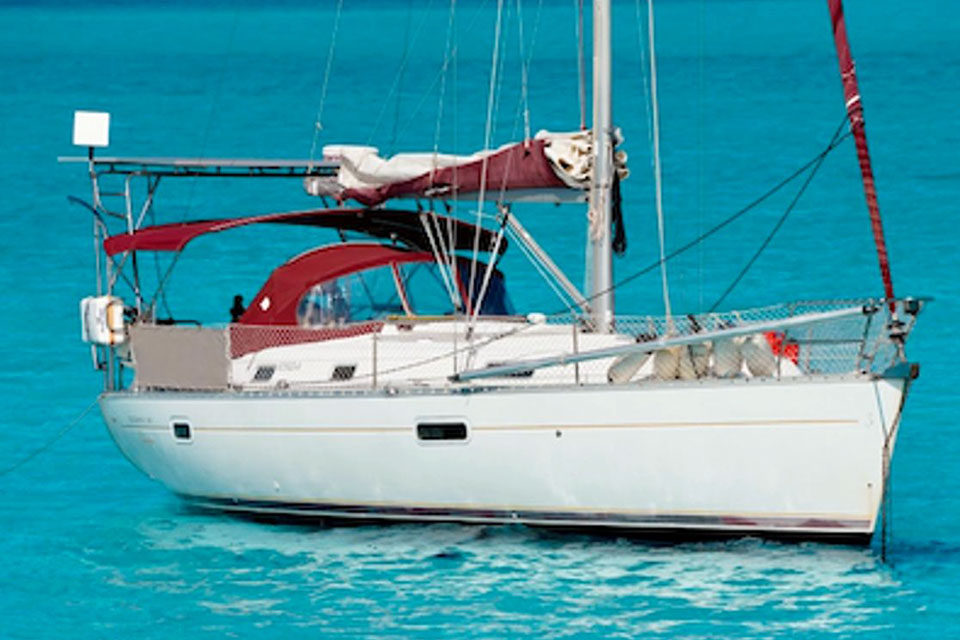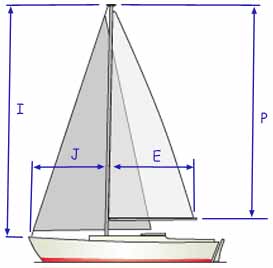- Home
- Cruising Yachts 35' to 40'
- Beneteau Oceanis Clipper 361
The Beneteau Oceanis Clipper 361 Sailboat
Specs & Key Performance Indicators
The Oceanis Clipper 361 sailboat, designed by French naval architects Jean Berret and Olivier Racoupeau, is a product of Beneteau, a shipyard based in Saint-Gilles-Croix-de-Vie, France.
 The Beneteau Oceanis Clipper 361
The Beneteau Oceanis Clipper 361Published Specification for the Beneteau Oceanis Clipper 361
Keel & Rudder Configuration: Fin keel with spade rudder
Hull Material: Fiberglass (GRP)
Length Overall: 11.10 meters (36'5")
Length on Deck: 10.80 meters (35'5")
Waterline Length: 9.25 meters (30'4")
Beam: 3.80 meters (12'6")
Draft: 1.55 meters (5'2")
Rig Type: Masthead Sloop
Displacement: 6,000 kilograms (13,227 lbs)
Ballast: 1,900 kilograms (4,188 lbs)
Water Tank Capacity: 400 liters (105 gallons)
Fuel Tank Capacity: 75 liters (20 gallons)
Hull Speed: Approximately 7.2 knots
Designer: Jean Berret & Olivier Racoupeau
Builder: Beneteau
Year First Built: 1999
Year Last Built: 2004
Options & Alternatives
Buyers of the Oceanis Clipper 361 sailboat had two design options to choose from:
- Draft: The sailboat was available with two keel options: a standard deep draft keel and a shallow draft keel. The deep draft version had a draft of approximately 1.90 meters (6'3"), while the shallow draft version had a draft of around 1.55 meters (5'1").
- Interior Layouts: The interior layout options included a two-cabin or three-cabin configuration. The two-cabin layout featured a larger aft cabin and a more spacious head, while the three-cabin layout provided an additional aft cabin, making it suitable for larger crews or families.
Sail Areas & Rig Dimensions
The sail areas and rig dimensions for the Oceanis Clipper 361 sailboat are as follows:
I: 13.78 meters (45'2")
J: 4.25 meters (13'11")
P: 11.70 meters (38'5")
E: 4.40 meters (14'5")
Main Sail Area: 28.6 square meters (308 square feet)
Genoa Area: 35.9 m2 (386 ft2)
Total Sail Area: 64.5 m2 (694 ft2)
Published Design Ratios
The Key Performance Indicators (KPIs)
- Sail Area to Displacement Ratio (SA/D): 21.11
- Ballast to Displacement Ratio (B/D): 31.34%
- Displacement to Length Ratio (D/L): 178.91
- Comfort Ratio: 19.40
- Capsize Screening Formula (CSF): 2.18
Here's how to calculate the KPIs yourself - without having to wrestle with the mathematics...
Based on the published design ratios, these are the theoretical sailing characteristics of the Oceanis Clipper 361 sailboat:
- Sail Area to Displacement (SA/D) Ratio: A SA/D ratio of 21.11 indicates that the Oceanis Clipper 361 is a relatively high-performance sailboat. This implies that the boat has an ample sail plan relative to its displacement, which should translate to good speed and responsiveness under sail.
- Ballast to Displacement (B/D) Ratio: A B/D ratio of 31.34% suggests that while the boat has a reasonable amount of ballast for stability, it is not overly stiff. Boats with a B/D ratio above 40% are considered very stiff and powerful, so 31.34% indicates moderate stiffness.
- Displacement to Length (D/L) Ratio: With a D/L ratio of 178.91, the Oceanis Clipper 361 falls into the light displacement category (100-200). Light displacement boats accelerate quickly, have less resistance to the water, and are generally considered to have better performance capabilities compared to heavier displacement boats.
- Comfort Ratio: At 19.40, the Oceanis Clipper 361 is on the lower end of the comfort scale. This suggests that the motion on board might be a bit more pronounced and less comfortable, akin to that found on a lightweight racing boat. It indicates that the boat might be less comfortable in heavier seas, which is important for extended cruising.
- Capsize Screening Formula (CSF): A CSF of 2.18 is slightly above the threshold of 2.0, which is generally considered the upper limit for blue water capability. This suggests that while the Oceanis Clipper 361 might have reasonable offshore capabilities, it is more ideally suited to coastal cruising rather than long ocean passages.
Summary
In summary, the Oceanis Clipper 361 is a light displacement sailboat with high performance potential due to its high SA/D ratio. It has moderate stability and stiffness, and while it offers good performance, it may be less comfortable in rough seas and possibly more suited for coastal cruising rather than extended blue water passages.
Design Ratios: Notes of Caution...
- The Sail Area/Displacement Ratio (SA/D): This ratio provides an estimate of the sail power relative to the boat's weight, which can indicate potential speed in various wind conditions. But it doesn't account for the efficiency of the sail plan, the rigging, or the skill of the crew. Real-world performance can vary significantly based on these factors.
- The Ballast/Displacement Ratio (B/D): This ratio gives an idea of the boat's stability and stiffness, which is crucial for handling and safety. But it doesn't consider the distribution of the ballast or the hull shape, both of which can greatly affect stability. A high B/D ratio alone doesn't guarantee a stable boat if the ballast is poorly distributed.
- The Displacement/Length Ratio (D/L): This ratio helps predict the boat's speed potential and its behaviour in different sea conditions. But it doesn't account for the hull design or the boat's overall weight distribution. Two boats with the same D/L ratio can perform very differently if their hull shapes are different.
- The Comfort Ratio (CR): This ratio estimates the boat's motion comfort in a seaway, which is important for long passages. But it doesn't consider the boat's interior layout, which can also affect comfort. Additionally, personal tolerance to motion varies, so a boat that is comfortable for one person might not be for another.
- The Capsize Screening Formula (CSF): This formula assesses the likelihood of a boat capsizing in heavy seas, which is critical for offshore safety. But it doesn't take into account the boat's handling characteristics or the skill of the crew. A boat with a low CSF can still capsize if poorly handled in severe conditions.
General Limitations
- Static Nature: These ratios are static measurements and don't account for dynamic factors like wave action, wind gusts, or crew actions.
- Simplification: They simplify complex interactions into single numbers, which can be misleading. Real-world performance is influenced by a multitude of factors that these ratios can't fully capture.
- Context: The context in which the boat is used (e.g., coastal cruising vs. offshore racing) can greatly affect how these ratios should be interpreted.
In summary, while these ratios provide valuable insights into the theoretical performance characteristics of a sailboat, they should be used as part of a broader assessment that includes practical experience, sea trials, and expert advice.
This article was written with the assistance of Gemini, a large language model developed by Google. Gemini was used to gather information, summarize research findings, and provide suggestions for the content and structure of the article.
Recent Articles
-
Is Marine SSB Still Used?
Apr 15, 25 02:05 PM
You'll find the answer to this and other marine SSB-related questions right here... -
Is An SSB Marine Radio Installation Worth Having on Your Sailboat?
Apr 14, 25 02:31 PM
SSB marine radio is expensive to buy and install, but remains the bluewater sailors' favourite means of long-range communication, and here's why -
Correct VHF Radio Procedure: Your Questions Answered
Apr 14, 25 08:37 AM
Got a question about correct VHF radio procedure? Odds are you'll find your answer here...













